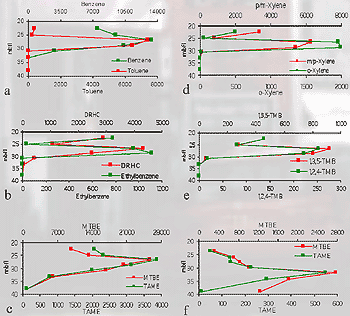
![]()
G P Wealthall, S F Thornton and D N Lerner
Groundwater Protection and Restoration Group,
University of Sheffield, UK
www.sheffield.ac.uk/gprg
Dissolved Phase Plume
The LNAPL has migrated below the water table, with dissolution of the product resulting in contamination of the saturated zone with a range of petroleum hydrocarbons including diesel range organics (DROs), benzene, toluene, m/p-xylene & o-xylene (BTEX), MTBE, TAME and other aromatic compounds. Two superimposed plumes are present in the contaminated aquifer at this site:

Selected organic contaminant-depth profiles at 30 m from the source
(a-e) and 115 m from the source (f). Concentration expressed as ug L-1.
- A mixed plume of DROs, BTEX, MTBE and TAME extending from the site to 40 mbfl and 30 m downgradient
- A plume of MTBE and TAME, extending from 40-115 m downgradient of the site to at least 41 mbfl
- The distribution reflects the early release of the more soluble oxygenates
- The plume of dissolved phase contaminants is sinking with increasing downgradient transport due to migration along horizontal bedding plane fractures (1-3º dip)
- A semi-confining hard ground (64 mbfl) may limit the depth of plume migration, if this hard ground is laterally continuous

